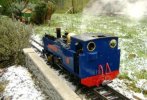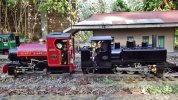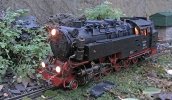Madman
Registered
Is your track raised enough were you don't have to bend too low to do things..
Good point Sean. The answer is no.
Is your track raised enough were you don't have to bend too low to do things..
Good point Sean. The answer is no.


Good advice, but we've used plastic Peco track at Brambleton for many years with no problems. There are special bays for coal firing, but rthats a different kettle of steamUse wood sleepered track or a wood board with grooves gauged for your loco, you can melt plastic sleepers under a stationary loco left unattended with the burner turned up full,
True, but, well, live steam is live steam!Electric:
Spontaneous, instant gratification, simple to operate, impervious to grades, pretty much. Run ‘em five minutes or hours.
I have a Vincent and my good friend has a Challoner. Non-geared Regners do not seem very common in the UK. A few years ago someone brought an Emma to one of my open days; and it was indeed a fine loco. A bit more recently a friend brought this beast of an engine to test on my line. Originally built from a Regner kit, with every conceivable refinement: whistle, draincocks, lights etc - all r/c.As for Regner: some of their models are indeed meant as 7/8" scale, as are their Lorry kits.
I have their Emma which fits beautifully with my G Scale stuff. I went to Germany to pick it up at their factory, and got an extensive lesson in driving and handling it. My knowledge of the German language was stretched to the limit! Afterwards, any question from me was quickly answered by e-mail. (They do understand English, by the way.)
It runs beautifully, it's surprisingly strong and at the same time easily manageable. It has the water top-up feature. I had them install a whistle, which is powered by steam from the kettle and activated from the RC. If you've raised enough steam, the whistle will be loud enough to scare your neighbours.
Keep in mind that a Regner loco may seem quirky if you're used to Roundhouse or Accucraft, because these people tend to find their own solutions. So in that case you'd have a bit of a learning curve.
Here it is, and you can see that even an R0 curve (422 mm) is no problem. It's the curve on the near right hand side.

Chris Vernell already mentioned an importer in the US for Roundhouse.
I should forget the Mamod as it is generally agreed that it takes a lot of time, effort and cash to make them run properly and even then they are second rate.
I also mentioned this elsewhere:
Okay so not in a normal garden scale this is Spur 1 which is 1:32 running on 45mm track. It is live steam however and a snip at € 4300 / £ 3765 / $ 5010 but before you whip out the credit card they are on holiday until Friday. Just look at it, Oooooo

(1HPC12) ASTER Spur 1 Dampflok Gt2x4/4 Bayern, Echtdampf Live Steam - Modelleisenbahn Ankauf & Verkauf | Bimmelbahn24
Das Spur 1 Modell einer Dampflok Gt2x4/4 MALLET Bayern, befindet sich in gutem Zustand und wird in starker Luftpolsterung und stabiler Kartonage geliefert. SPIRITUS ! ECHTDAMPF, LIVE STEAM ! Wurde von unserem externen Echtdampfspezialisten erfolgreich geprüft. Unsere Bilder sprechen für sich...www.bimmelbahn24.de
Jason Kovak at The Train Department in the handles Roundhouse (as well as Accucraft, Aster, Bownande, etc.) - no connection other than a satisfied customer.Madman, welcome to live steam! As people have said, it not as easy as battery power, but highly addictive! If this is your first live steamer, Roundhouse are excellent, but im not sure of shipping to you. The other thing to think about is ease of use. Some locos look wonderful, but can be "interesting" to run!
Also dont forget Accucraft in your neck ofvthe woods!
Very nice - how did it handle your curves and points?I have a Vincent and my good friend has a Challoner. Non-geared Regners do not seem very common in the UK. A few years ago someone brought an Emma to one of my open days; and it was indeed a fine loco. A bit more recently a friend brought this beast of an engine to test on my line. Originally built from a Regner kit, with every conceivable refinement: whistle, draincocks, lights etc - all r/c.
View attachment 349346
Well yes the original Mamods do, but in later years there was at least one possibly more geared ones that would be tamable.One factor you should consider when buying any large scale locomotive including live steam is what minimum radius curves do you want/need to run on?
Not sure of the minimum radius curves this Mallet need but if it is like the Accucraft NA locomotives it will need a larger radius than many of the LGB products. Bachmann's Fn3 (1:20.3) Mallet is not a true Mallet - in that its rear drive unit also pivots allowing it to get round tighter curves than it should.
And as for live steam - go Roundhouse for your first loco - Jason Kovak at the Train Department is as helpful as Roundhouse are to there customers.
Accucraft for detail - if you are prepared to sometimes get an engine that needs fettling (look for my 7/8"Decauville posts on this forum).
And run away from Mamod - as they tend to run away.............
We only gave it a short test run before it got dark. It was ok on the R5 curves and points that I have on most of my line. We didn't try it on the R3 loops at either end.Very nice - how did it handle your curves and points?
